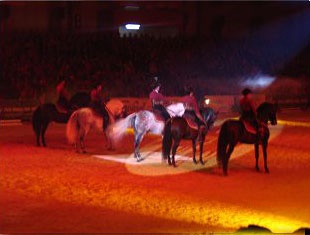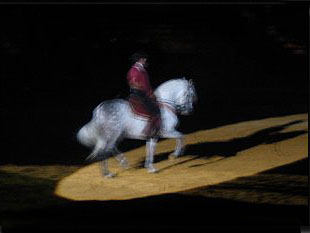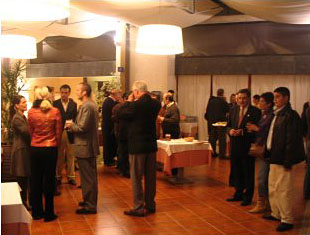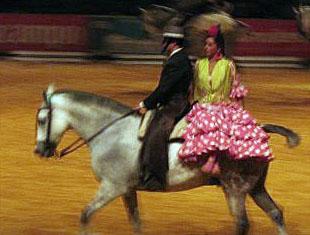
There’s nothing in the world like SICAB. Every November in Sevilla, Spain’s National PRE Breeder’s Association (ANCCE) hosts the world’s largest “trade show” dedicated to one subject—the Pure Bred Spanish Horse (PRE). The Salon Internacional del Caballo, or SICAB as it is better known, is a horse show that redefines the venue.
Not only is it a breed show that brings together thousands of the top exemplars in the country after a highly competitive qualifying season, it also sponsors a series of competitions in both national and internationally-competed equestrian sports such as Doma Vacquera, High School Equitation, and Dressage. Government dignitaries and members of Spain’s Royal Family are regular attendees, as are film and sports stars and other celebrities from all over Europe. Well over a million people on the weekend alone fill the aisles of the five pavilions and several outlying tents and arenas at the Palacio de los Congressos, a golden-domed, palatial convention center on the northern edge of Sevilla, one of the most gorgeous baroque cities in Europe.
Large television screens throughout the buildings project the various events from the three competition arenas to the milling public, who can choose between shopping in the dozens of booths filled with all things equestrian, viewing hundreds of champion mares stabled in their own wing, or browsing the pavilion of breeders’ stands that offer food, drink and flamenco. Those who choose to stay ringside, will see the best examples of the PRE breed, mares and stallions, in competition in both morphology (conformation) and functionality along with the Copa ANCCE, the riding finals, and many exhibitions and demonstrations in the equestrian arts.
 Outside of the pavilions, in the lots surrounding the palacio, another kind of show takes place. Here is where the stallions are stabled, schooled and groomed for their upcoming classes. If you ask any foreigner standing around, the most amazing thing about this environment is the way that hundreds of stallions stable together, are groomed and herded together three- and four-across down narrow aisles, are ridden side by side in large groups and are touched and stroked by hundreds of strangers without a single incident—no arching, stomping, rearing or screaming as you would commonly see in stallions in other breeds. True to their reputations, the sensibility of the PRE is legendary, and is a matter of routine for the Spanish. A four-year-old child, on the back of a substantial chestnut stallion, rides her way through the crowd, her mother idly strolling with friends a good twenty-five yards behind. A seventy-year-old man leads his two prize black three-year-olds through a line of eight mounted vacqueros waiting to enter the show ring—their heads and their steps are high, but they gently see their aged owner through the crowd. The stallion area is where a breeder will pull out his champion and let you put your hand to his croup, examine his legs, watch his movement as he trots down the pavement, and book your next breeding. Or maybe you have fallen in love with a particular animal that you have seen in a class or a demonstration. The stallion stalls is where the deals are made. Unfortunately, it is also the place where the unwise purchaser has paid a premium for a breeder’s problem stock. Like anywhere there are horses, bad deals and suckers are born every day.
Outside of the pavilions, in the lots surrounding the palacio, another kind of show takes place. Here is where the stallions are stabled, schooled and groomed for their upcoming classes. If you ask any foreigner standing around, the most amazing thing about this environment is the way that hundreds of stallions stable together, are groomed and herded together three- and four-across down narrow aisles, are ridden side by side in large groups and are touched and stroked by hundreds of strangers without a single incident—no arching, stomping, rearing or screaming as you would commonly see in stallions in other breeds. True to their reputations, the sensibility of the PRE is legendary, and is a matter of routine for the Spanish. A four-year-old child, on the back of a substantial chestnut stallion, rides her way through the crowd, her mother idly strolling with friends a good twenty-five yards behind. A seventy-year-old man leads his two prize black three-year-olds through a line of eight mounted vacqueros waiting to enter the show ring—their heads and their steps are high, but they gently see their aged owner through the crowd. The stallion area is where a breeder will pull out his champion and let you put your hand to his croup, examine his legs, watch his movement as he trots down the pavement, and book your next breeding. Or maybe you have fallen in love with a particular animal that you have seen in a class or a demonstration. The stallion stalls is where the deals are made. Unfortunately, it is also the place where the unwise purchaser has paid a premium for a breeder’s problem stock. Like anywhere there are horses, bad deals and suckers are born every day.
 This year’s SICAB was one of the best in the seven years that this author has attended. The quality of the young stock is the area in which the biggest advances have been made. Several years ago at one of my first SICABs, I encountered a coach of a European Olympic team and he commented at that time that he had seen more progress within the Spanish breed in the ten years prior than in any Northern European breed. Now, in 2005, I have to say that I have seen the progress with my own eyes. The younger stallion classes and the mare classes especially are presenting a larger horse, with a longer forearm and a more active hind-end, which is producing a forward ground-covering trot and an easy extension with just the slightest request from the handler. At the same time, the prototype, which remains baroque, is somewhat closer to the sporthorse body type that still remains fully within breed standards. While keeping the uphill rolling canter which is a strength of the race, the breeders are seeking to improve the walk and the quality of the trot. A danger to this, however, can be seen in subjects who present a bigger trot through the development of a somewhat longer back, but then exhibit an inexpressive or lateral canter—faults commonly seen in the Northern European breeds. The Champion Stallion of Spain for 2005 was awarded to Rondeno IX from the Yeguada Centurion.
This year’s SICAB was one of the best in the seven years that this author has attended. The quality of the young stock is the area in which the biggest advances have been made. Several years ago at one of my first SICABs, I encountered a coach of a European Olympic team and he commented at that time that he had seen more progress within the Spanish breed in the ten years prior than in any Northern European breed. Now, in 2005, I have to say that I have seen the progress with my own eyes. The younger stallion classes and the mare classes especially are presenting a larger horse, with a longer forearm and a more active hind-end, which is producing a forward ground-covering trot and an easy extension with just the slightest request from the handler. At the same time, the prototype, which remains baroque, is somewhat closer to the sporthorse body type that still remains fully within breed standards. While keeping the uphill rolling canter which is a strength of the race, the breeders are seeking to improve the walk and the quality of the trot. A danger to this, however, can be seen in subjects who present a bigger trot through the development of a somewhat longer back, but then exhibit an inexpressive or lateral canter—faults commonly seen in the Northern European breeds. The Champion Stallion of Spain for 2005 was awarded to Rondeno IX from the Yeguada Centurion.
The piaffe and passage remain the calling card of the breed, and ability for it is everywhere and, frankly, overwhelming. Young untrained colts show an aptitude while standing in line in a class or walking off with their handlers, and the trained horses simply all do it. My rider and I stood for hours at the schooling rings, watching Spanish horses in all types of tack, with all types of riders, executing piaffe and passage willingly and with ease, at levels rarely seen in American Grand Prix rings. If you think we are exaggerating, I can only invite any skeptical reader to come and see it for herself. This breed has a natural affinity for the highly collected movements. The piaffe and passage are elements of basic horse training in all the Spanish riding traditions, unlike the German system where these movements are attempted later in a horse’s training and considered the peak of dressage performance. That said, many of the Spanish horses that can perform easily a competitive piaffe and passage may never have the more forward gaits that the sport of dressage requires. However, as a greater understanding of the demands of modern competitive dressage (or Doma Clasica in Spanish) spreads among the breeders in Spain, a well-rounded horse is emerging that offers both the collected aptitude as well as the ability to lengthen and amplify the strides.
Examples of this were seen consistently in the Copa ANCCE (or the “Breeder’s Cup”) dressage competitions. The four-year old class was especially strong, where young horses, soon to be five, completed a test similar to the first level test in the States. Similarly, the five and six-year old classes correspond to the second and third levels in America. At seven, the horses are competing at Prix St. George and schooling most of the Grand Prix movements. The Copa this year consisted of a finals class for the three lower levels and the PSG, a finals for the Intermediare I Kur, and a B test and Kur for the Grand Prix Championship. The finals held at SICAB are only competed by PRE horses, but compliment Spain’s advanced system of open shows, which are rated A, B, or C level (by quality of competitors, judges and number of qualifying points) in addition to Jovenes (Young Riders) and Infantiles (Juniors). ANCCE, the national breed organization for the PRE, is also sponsoring a number of these open shows as well as a Dressage Institute (called CAR-ANCCE) for select horses within the breed, who receive upper level dressage training from Hank Van Bergen, among others.
 Every night, and twice on weekends, an “Espectaculo” is performed for a packed audience. In prior years, traditional riders have performed in Spanish attire and themes (as they did for the crowd in Jerez at the World Games), or breeders have celebrated one of the country’s most illustrious stallions through an exhibition of his life and offspring, or a retrospective of the Iberian Horse in History has been performed. This year, the Real Escuela Andaluza del Arte Ecuestre, Spain’s own Royal Riding School, performed the extravaganza. Led by the inimitable Rafael Soto, the riders and trainers performed breathtaking exhibitions of the High School training for which the Foundation in Jerez is known. It is not often that one can watch a top-ten Olympic dressage rider perform nightly in his “day job”, so to speak, working horses in hand as well as under saddle.
Every night, and twice on weekends, an “Espectaculo” is performed for a packed audience. In prior years, traditional riders have performed in Spanish attire and themes (as they did for the crowd in Jerez at the World Games), or breeders have celebrated one of the country’s most illustrious stallions through an exhibition of his life and offspring, or a retrospective of the Iberian Horse in History has been performed. This year, the Real Escuela Andaluza del Arte Ecuestre, Spain’s own Royal Riding School, performed the extravaganza. Led by the inimitable Rafael Soto, the riders and trainers performed breathtaking exhibitions of the High School training for which the Foundation in Jerez is known. It is not often that one can watch a top-ten Olympic dressage rider perform nightly in his “day job”, so to speak, working horses in hand as well as under saddle.
Another highlight of the week was the second annual SICAB horse auction, which was held on Friday afternoon. The SICAB auction is an attempt to initiate (or imitate) the successful young horse auction traditions from Germany and Holland. Reviews are mixed regarding the success of the two auctions. The sale itself has not yet attracted the international market, which will inevitably bring the higher prices as it often has in the Northern European sales rooms. Many of the horse owners bought in their own horses, and word has circulated that many private sales occurred following the auction itself. Additionally, the selection process has proven to be problematic. The breed association is guaranteeing the soundness and health of all the animals sold, and given the Spanish propensity toward beaurocracy and red-tape, the process has become a function of yet another official committee, which has slowed down the selection and reduced the number of horses, resulting in a line-up of horses that does not yet reflect the variety and quality of the breed. Nevertheless, prices were higher this year than last, more people participated, and better horses were represented. This venue for sales will take time, but the Spanish are aware of their need to approach the market in this way, and it should develop well as more people have confidence in the methodology.
A small group of Americans are regulars at SICAB. The majority of these are breeders of the PRE, primarily from the West Coast, and are headed by the President of the Foundation for the Pure Spanish Horse, Barbara Currie, who has recently accepted the distinguished role of President of the International Breeders Association (FICCE). Other notable Americans who attended are: Alexander Zilo of Wellington, FL, who himself owns a SICAB National Champion Stallion; Margaret Carrera of California who owns and sponsors a Grand Prix Spanish Horse; Mel Currie, Avi Cohen and Barbara Clark from the Foundation; and Jeff and Lee Burton, a USDF All-Breeds Award winner on a PRE. Grand Prix rider Pati Pierucci was seen riding in several of the warm-up arenas. Juan Matute (a Spaniard who keeps a home in Wellington, FL) was a regular at ringside, along with a number of brand new PRE horse owners from the States who made the trip. Alex Zilo sponsored an elegant reception for all attending Americans at the Congressos Hotel across from the Palacio, with champagne and an unending array of Spanish delicacies.
This year’s Grand Prix was judged by an international panel of five judges. Seven horses competed, all young competitors at Grand Prix, several with future team aspirations. The only competitor with past Spanish Team participation was the winner, Teresa Juaquicoa on Impaciente, who was one of the young riders who represented Spain at Aachen this past summer when the regular team (Soto, Jiminez, Ferrar-Salat, and Rambla) chose to take some time off following their Bronze Medal at the European Championships. Four of the seven pairs competed in last September’s Spanish National Championships in Castro del Rio.
Victor Alvarez on Selecto earned scores almost identical to his performance in the National Championships, with a median score of 65.392 for the weekend. His ride on Selecto was slightly less brilliant than in September, but we continue to like this horse and expect good things from the two of them.
Two riders whose performances and scores did improve significantly since the National Championships were Jauquicoa and Rafael Ortiz on G-Nidium. Jauquicoa’s horse Impaciente is considered one of the best young Grand Prix horses in the country at the moment, and is admired by riders all the way up to the Olympians. Jauquicoa is a young rider, and at times it appears that her horse succeeds in spite of herself. She remains very active in the saddle, and rides with a persistent driving seat which is unusual to see on the Spanish horses. Nevertheless, she is effective and the horse has a purely outstanding piaffe and passage tour. The overall picture is one of real potential. The pair continue to improve their scores, and as they becomes more experienced and better trained, one can imagine an international career. She won the Grand Prix easily with a median score of 67.238. Second-place winner Rafael Ortiz, on G-Nidium, had perhaps the best weekend of his young horse’s career. This pair finished 8th overall at the Nationals, but this weekend raised his median score by two percentage points to finish just under a 66%. The horse is another exceptional mover, on the small side, with notable elasticity, regularity and yet extravagance. What may have hurt the pair is the difficulty to distinguish between the working trot and the passage, which the horse maintained throughout the entire trotting portions of the B test. It will be interesting to see if this rider and horse will continue to move up the ranks. The best way to visit SICAB for the first time is to contact the PRE Breed Association in your own country for travel information and tours, or visit www.ancce.com. In the United States, contact the Foundation for the Pure Spanish Horse in Beverly Hills, California.
Text and Photos by: Kimberly Van Kampen Boyer - Hampton Green Farms
Related Links
Jimenez Wins 2005 Spanish Dressage Championships in Home Town
Eurodressage On the Scene at the 2002 World Equestrian Games